Abstract
Proteins are vital players that mediate a vast majority of cellular functions. NMR spectroscopy originally developed by physicists for investigation of nuclear properties, now represents highest applications in chemistry and biochemistry. NMR has been extensively utilized by structural biologists for exploring protein-ligand interactions and by medicinal chemists for drug discovery. The ligands investigated involved small organic molecules, peptides, proteins and nucleic acids. Recently, there has been increasing interest in the dynamic studies of these protein-ligand interactions. These applications are provided by a multitude of NMR experiments ranging from the simple one-dimensional 1H spectrum to complex multidimensional NMR approaches. Chemical shift perturbation analysis allows for delineation of the binding interface, determination of the dissociation constants and estimation of ligand binding kinetics. Paramagnetic Relaxation Enhancement NMR spectroscopy has been widely used to visualize the weakly populated states and describes the process of protein complex formation. These approaches have been demonstrated for substrate binding, allostery, state equilibria and macromolecular self-association. NMR spectroscopy allows for characterization of minor conformational dynamic differences in structurally similar proteins. Target Immobilized NMR screening represents another approach to drug discovery that allows ligand screening for challenging targets. NMR spectroscopy can also be applied in combination with other techniques including X-ray crystallography and various computational methods to achieve greater coverage than any of the individual methods. This chapter is focused on the applications of NMR in exploring protein-ligand interactions and dynamics.
Keywords: Chemical shift perturbation, Encounter complex, Ligand binding, NMR, Paramagnetic relaxation enhancement, Protein dynamics, Protein-ligand interaction, Spectroscopy, Specific complex, Target immobilized NMR screening.






















